Dive Brief:
- Twitter is adding direct message cards designed to encourage discovery of chatbots linked through organic sharing and Promoted Tweets, according to a blog post by the company.
- Twitter has been testing the direct message cards with brands like Patrón Tequila, which is using them to promote a “bot-tender” that asks a series of questions and makes personalized cocktail recommendations. Marketers that want to test the cards have to speak with Twitter sales rep for access, Travis Lull, senior product manager at Twitter, said in the blog post.
- Marketers can target a direct message card to capture people’s attention with images or video and include up to four fully customizable call-to-action (CTA) buttons. Each CTA button takes the user into a specific experience within direct messages, Twitter said.
Dive Insight:
While bots can be clunky and limited in their conversational abilities, they are being rapidly adopted to handle interactions between businesses and their customers. However, one of the big challenges for brands is letting consumers know a bot is available when they are engaging on a platform like Twitter where the messaging experience is available. This is the challenge Twitter is hoping to help marketers address with Direct Message Cards.
Facebook Messenger chief David Marcus said at the company’s F8 developer conference this year that there are now 100,000 bots on the messaging service, up from 33,000 last September. About 20 million businesses are fielding customer questions in Messenger, he said.
In the past few weeks, heavyweights like Facebook, Google and Microsoft have announced new ways to find bots on their chat platforms, according to Venture Beat. Microsoft said last month at its annual developers conference that the 130,000 software programmers using the company's Bot Framework can publish their bots on its Bing search engine. With that kind of progress in support for bots, they'll likely continue to expand in use as more companies and users grow accustomed to the new tech and bots become increasingly human-like.











